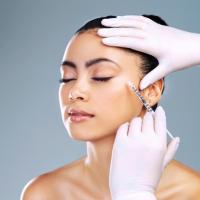Home > Blog > Cosmetic Surgery
What Aftercare Is Necessary for Breast Implant Surgery?
A breast implant surgery, also known as a breast augmentation, changes the size or shape of the breasts through implants or a natural tissue transfer.
This procedure can offer a renewed sense of confidence and help patients achieve their aesthetic goals. It is also important for patients to engage in good aftercare practices. Doing so helps maintain optimal results and can improve recovery timelines.
Postoperative medications
In a breast augmentation surgery, the plastic surgeon will most likely prescribe pain medication for the first few days after the surgery. While taking this medication is optional, relieving any discomfort and pain the patient is experiencing may make it possible to get more sleep and thus better support the body’s healing.
Additionally, the plastic surgeon may prescribe medical-grade scar cream. Applying this cream as prescribed helps further minimize any scarring.
The importance of rest
Rest is critical in giving the body the support it needs to heal. Taking it easy allows the body to devote energy and resources for healing as quickly as possible, particularly in the first days after a breast augmentation surgery.
After the first few days, some patients will feel fine and wish to return to all normal activities. Even if a patient is not experiencing discomfort, though, their body is still engaged in the process of healing.
It is therefore important to honor the need to rest, as well as follow the activity restrictions detailed below. This may mean planning ahead of the surgery to do certain tasks that will make it easier to rest immediately afterward, such as grocery shopping, having comfortable clothes on hand, and getting support with childcare.
Personal hygiene and dressing
As part of the aftercare process, patients will receive detailed instructions from their plastic surgeon, including how best to clean and protect sites of healing. Following these instructions can help prevent infection, reduce swelling, minimize scarring, and improve recovery timelines.
The plastic surgeon will usually provide patients with customized post-operative bras to help support the healing process.
These garments help with recovery by:
- Stabilizing implants so that they do not shift
- Supporting proper lymph node drainage by providing mild compression
- Increasing circulation, which helps promote healing
Patients should plan on wearing these bras in accordance with their recovery guidelines.
Patients should also anticipate that, in the first few days after surgery, they may not be able to lift their arms overhead. Because of this, it can be helpful to have loose-fitting shirts that button down the front on hand.
Hydration and healthy eating
The patient can support their body’s healing by staying hydrated and eating healthy foods after their breast augmentation procedure.
Whether or not someone has just had a medical procedure performed, staying hydrated helps the blood perform key jobs, including transporting nutrients to sites of healing and carrying away waste. After surgery, it is even more important to stay hydrated so that the body can successfully perform these functions.
Good nutrition is another way patients can support natural recovery processes. Healthy food supplies the body with much-needed energy and valuable nutrients.
Activity
Adhering to activity restrictions is critical for minimizing strain on the body so that it can heal. Activity restrictions also help ensure that implants do not shift. Please note that feeling better is not the same thing as being fully healed.
The first few days
In the first few days after surgery, patients will most likely feel sore, and adhering to rest protocols may be fairly straightforward. Most patients find that they can return to work at a desk or other minimally-active routines after a few days.
One to two weeks
After one to two weeks, patients may return to lower body exercise such as spinning or walking. Please note that this does not include yoga, core training, or lifting anything over ten pounds.
Four to six weeks
After four to six weeks, a patient may be cleared by their plastic surgeon to return to normal activities. This includes full-body workouts or any exercise involving the upper body or core, as well as any exercise that is jarring (like horseback riding).
Adhering to aftercare supports optimal results
The plastic surgeon a patient chooses to work with will have a major impact on the results of the surgery—this is why it is always recommended to work with an experienced surgeon who is certified by the American Board of Plastic Surgery.
Patients also have an active role to play in achieving optimal results through their adherence to aftercare protocols. Using medications as prescribed, getting enough rest, staying hydrated, and eating healthy foods all support the body in a faster and more effective healing process.
Additionally, following post-procedure hygiene protocols, using custom support garments, and adhering to activity restrictions helps to ensure that implants do not shift and tissue has an opportunity to fully heal before being stretched or strained in a workout.
As always, patients should take full advantage of the consultation with their plastic surgeon to ask any questions about how personal activities and routines might shift during the aftercare period.
More to Read:
Previous Posts:






